The Special Characteristics of MRT Station Design
The architectural theory "Form follows function" explains the design of the MRT stations. The station forms are developed according to basic functionality. For example, the possibility of large numbers of passengers entering and exiting the stations in a sudden flow should be considered; passenger circulation should be planned simply and clearly; and space should be planned in modules systemwide. Furthermore, in addition to operational demands such as scheduling, the length and width of cars, and the variety of station types according to site conditions, architectural design should also consider the following factors:
◎ Passenger circulation
◎ Arrangement of ticketing facilities
◎ Location of elevators and escalators
◎ Rooms for staff and equipment
◎ Air conditioning and ventilation
◎ Facilities for the disabled
◎ Platform screen doors (to be installed initially on the Xinzhuang line of the long-term network)
Therefore, "form follows the function" is the first priority of station design. In this way, the design concept of transportation architecture differs from the design considerations of other public buildings.
Architectural styles vary on each line. On the first two MRT lines having started commercial services, namely, the Wenhu line (Muzha section) and part of the Tamsui line, the stations are elevated. Each line was given a specific theme, leading to unique identities in architectural design. The "high-tech" style of the Wenhu line (Muzha section) and the variations on traditional Chinese architecture on the Tamsui line have made their stations landmarks in their respective environments.
The station designs on the initial routes, such as the Zhonghe, Banqiao, Nangang, and Tucheng lines, emphasize the integration of the environment and aboveground objects such as entrances/exits and vent shafts. As for the interior, it is oriented towards simplicity while functionality is prioritized.
The stations on each of the subsequent lines, such as Xinlu, Songshan, and Xinyi lines were made to fit local environmental themes and cultural backgrounds as well as public art concepts in the development of station designs, and the protruding structures were required to have reduced volumes, be lightweight, and allow for permeability of lighting. The station interior finishing employed techniques such as variations in lines and materials, pattern collages, color conversions, and lighting to create visual foci which integrated with public artworks and created artistic atmospheres in station interiors with space variations and humanities.
The architectural form and interior finishing in stations mainly prioritized confirming the routes' design theme images or local development orientations and then considered overall planning concepts and interpretations of architectural modeling and style. However, because all of the site locations and conditions had their own unique characteristics, the styles and concepts of the different lines were not the same, and different representative meanings and styles were created. A brief description of the thematic and stylistic choices on different lines is provided below (for more photos, please refer to Taipei MRT (Chinese/English)):
Wenhu Line (Muzha section)
Glass and steel create a high-tech appearance. The Wenhu line (Muzha section) is the first medium-capacity transit (MCT) line in the Taipei area. Since all of the stations are elevated and most of them are located above streets, station design was strictly limited by clearances and related buildings codes. The minimal use of decorations, along with the use of glass and steel, creates the look and feel of modern-style architecture, and the stations' structure does not conflict with nearby buildings. (photo: Zhongshan Junior High School Station at the Muzha section on the Wenhu Line)
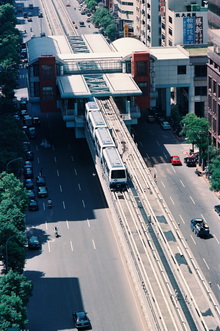
Tamsui Line
Spanning 22.8 km from the suburban Tamsui Station to Taipei Main Station, the Tamsui line is noted for its unique architectural characteristics. In the downtown area, tunnels were built under the route of the old Tamsui railway line. At ground level, station entrances are scattered and merged into various landscaped areas and pedestrian malls, providing local residents as well as transit passengers with a pleasant space to spend time in, to stroll around, and, of course, to travel in.
In the suburban part of the Tamsui line, station designs have many special features, not only reflecting the heritage of local architecture, but in some ways imitating the architectural elements adopted by our ancestors.
At-grade stations were built in the southern Fujian Province style, and the elongated northern imperial temples served as "blueprints" for elevated stations.
A special example is Jiantan Station, where the entire station structure was erected on two huge concrete columns and suspended, forming an overall image of a "dragon boat," an important feature of Chinese culture. Jiantan Station won the special Award, held by Architect Magazine, for urban landmarks in 1997.
The design basis of the keystone arches and brick walls of Tamsui Station, located in the heart of Tamsui District, stemmeded from the local colonial-era building known as "Fort San Domingo." (photo: Jiantan Station on the Tamsui Line)
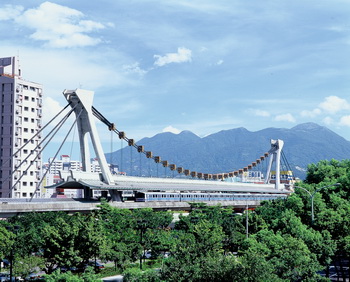
Zhonghe Line
The whole line is built underground and mainly passes through older districts with narrow roads. The design of this line does not try to create a new architectural style. Instead, its aim is an economical way of generating the renewal of its surroundings. In the construction of this line, joint developments with surrounding buildings were actively promoted. As for aboveground facilities, the principle is to avoid heavy impacts on the urban landscape. With no special landscaping or distinguishing outside features, the interior became the key point in station design. (photo: Nanshijiao Station on the Zhonghe Line)
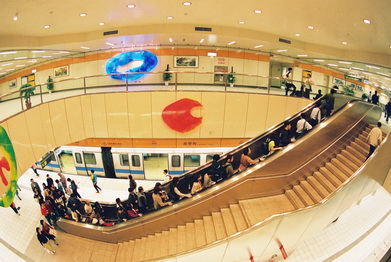
Xindian Line
All the stations are built underground. The line connects NTU Hospital Station downtown with Xindian Station in a suburban scenic area. Station design was not regulated by a monotonous style but rather stressed coherence with the surroundings, and specific characteristics for each station were emphasized. For example, the design elements of wall finishing, grille windows and the glaze-tiled roof of Chiang Kai-Shek Memorial Hall Station are clearly visible both inside and outside Chiang Kai-Shek Memorial Hall. The entrance to Jingmei Station is a simplified arcade while Gongguan Station uses roofs and octagonal windows which often appear in Chinese gardens. Guting Station, with its metal arches and glass, has light and transparent entrances that integrate with the modern steel and glass buildings nearby. The unique feature of this line is not the stations themselves but their integration with the architectural environment. (photo: Chiang Kai-Shek Memorial Hall Station on the Xindian Line)
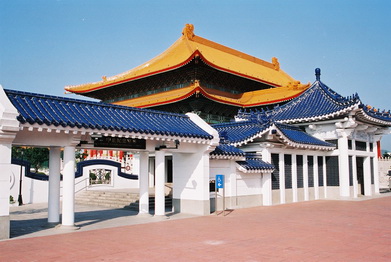
Banqiao Line & Tucheng Line
The design of underground stations mainly focuses on the integration of the environment and aboveground objects such as entrances and vent shafts. As for the interior, it is oriented towards simplicity while functionality is prioritized. (photo: Yongning Station on the Tucheng Line)
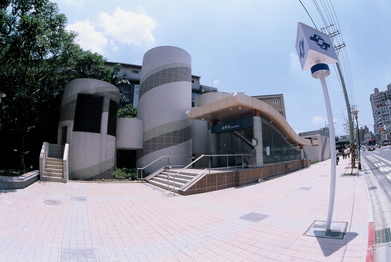
Nangang Line
This underground line connects the busy Ximen ("west-gate") area with the eastern commercial district. Therefore, the main design goals on this line are not to establish one architectural style but to integrate into the environmental context, to redefine the existing commercial spaces and activities by means of new transportation facilities, and to create a new commercial area along the underground malls connecting the MRT stations. The underground malls link areas that are separated by roads at ground level. Because land is expensive and sites for equipment are hard to acquire, vent shafts and ground-level entrances are reduced in size and designed in a simple style in order to avoid a heavy impacts on the urban landscape. Some vent shafts are even designed as public art to create new landmarks in urban spaces. (photo: Houshanpi Station on the Nangang Line)
Nangang Eastern Extension
(2) Taipei Nangang Exhibition Center Station(chinese)
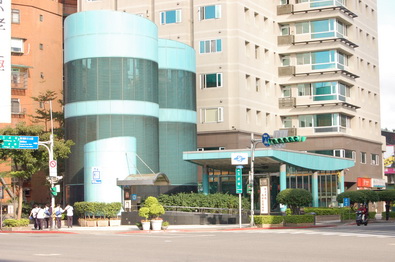
Wenhu Line (Neihu Section)
The Wenhu line (Neihu section) is an extension of the Wenhu line (Muzha section), which is a medium-capacity transit system. In addition to Dazhi Station and Songshan Airport Station, which are built underground, there are 10 elevated stations on the line. According to the environmental characteristics and human context of areas crossed by the MRT line, the architectural design languages can be divided into three categories, which are "Residential and Suburban Scenes," "Commercial and Recreational Environment," and "Industrial and Technological Landscape." With elevated stations as a main feature, these categories together form a theme entitled "River in the Sky." The design theme of the whole line is called "The Story of Lake City." (Neihu in Chinese means "inner lake.")
As for the station forms, public art is the starting point of the design theme and embodies the subtitle and color scheme for each station. Considering ease of maintenance and management as well as presenting an image of speedy MRT transportation, the station forms are designed neatly and geometrically, with a master form for all stations and their entrances on the Wenhu line (Neihu section). To fulfill the desire for a simplified form, most of the stations are designed as simple and light steel structures. Exterior walls are color-coated metal with enamel panels, and large glass windows are used to create lighting effects and transparency. The stations use a consistent architectural language and similar elements but vary according to the environmental conditions. (photo: Dahu Park Station on the Wenhu Line)
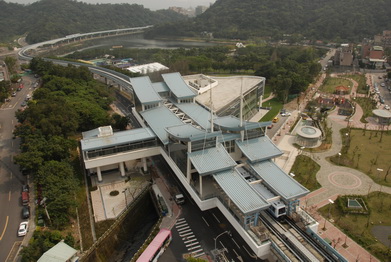
Luzhou Line
The scope and local characteristics of the Luzhou line are easily defined. The name "Luzhou" in Chinese means the "land of egrets" or the "land of reeds," both of which were formerly a feature of the scenery of the area. Therefore, the common design theme of the five underground stations is the egret. These birds are depicted in various ways, such as gliding with the winds, playing in the water and flying over treetops, and have been adopted to form a series of subtitles related to egrets, such as "Wind," "Water," "Reeds," "Sand," and "Fields." These sub-themes are presented in concrete or abstract form in the entrances and interior finishing to create the architectural character of this line. (photo: St. Ignatius High School Station on the Luzhou Line)
◎Station Description on the Luzhou Line (Chinese)
◎Design Concept of Stations on the Luzhou Line (PDF) (Chinese)
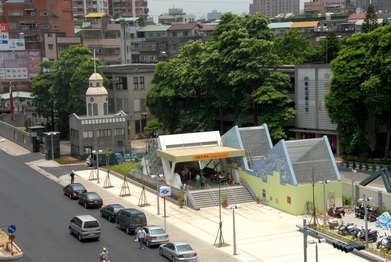
Xinzhuang Line
Starting with the Xinzhuang line and Luzhou line, the design of above-ground forms and interior finishings in stations will present new concepts. For example, in the contract of the detailed design consultants (DDC), DORTS has stipulated that the consulting team must include a public art curator, who will participate in the architectural design process and provide background analysis and investigation according to the environment and human context of the station. The aim is to establish a design theme that is integrated into the development of the overall design. In order to reduce the effect on the urban landscape and the visual impact on adjacent buildings, the form and volume of above-ground facilities will be reduced, and light and transparent materials will be utilized.
Furthermore, to create a bright, vivid and modern effect and decrease the claustrophobic pressure caused by the reduction of space within stations, special consideration is given to the interior finishing and the integration of the design theme with the overall architectural style. In passenger circulation intersection areas and waiting zones, the floor and ceiling patterns are specific on their line variations with graphics collages and color transitions which are designed to establish a visual focus. Public art installations will also add variety to the interior spaces and create an artistic atmosphere.
The Xinzhuang line is divided into two parts located in Taipei City and Taipei County respectively. The line passes through Taipei City, Sanchong City and Xinzhuang City, and has different characteristics and development backgrounds for each area. The architectural forms of the stations are designed under the guidelines provided in the previous paragraph, with an aim to integrate the local context into station design. (photo: Sanchong Station on the Xinzhuang Line)
◎Station Introduction at the Section of Taipei City on the Xinzhuang Line (Chinese)
◎Station Introduction at the Section of New Taipei City on the Xinzhuang Line (Chinese)
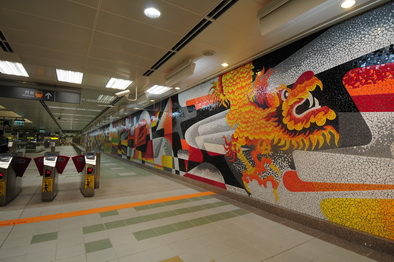
Xinyi Line
The street construction on the Xinyi line had "Dialog" as its theme, and the architecture and landscape design, planning of interior space, public art, and street furniture design, combined with lighting and color schemes created an MRT system with stations rich in artistic sensibility and local characteristics in order to integrate MRT architecture and landscape with the surrounding urban environment. (photo: Daan Park Station on the Xinyi Line)
◎Station Architecture and Public Art (2013 DORTS Annunal Report)
◎Introduction to the Xinyi MRT Line (Chinese/English)
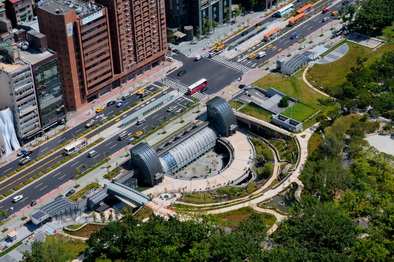
Songshan Line
During the planning of the Songshan line, each station's design theme was incorporated into the architecture finishing with variations in lighting, colors, and shades to present the different style of each station and provide a comfortable environment. At the same time, public art was selected which was suitable for each station. (photo: Songshan Station on the Songshan Line)
◎Station Architecture and Public Art of Songshan Line (2014 DORTS Annunal Report) (Chinese)
◎Introduction to the Songshan Line (Chinese/English)
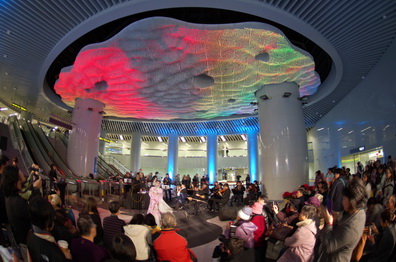
Tucheng Extension to Dingpu
The Tucheng extension runs underground from the terminus at Yongning Station along Zhongyang Road sections 3 and 4, and ends at the high-tech industrial park in Dingpu. The extension has a total length of 2 km with one underground station, and commercial service began on July 6, 2015. (photo: Dingpu Station on the Tucheng Extension)
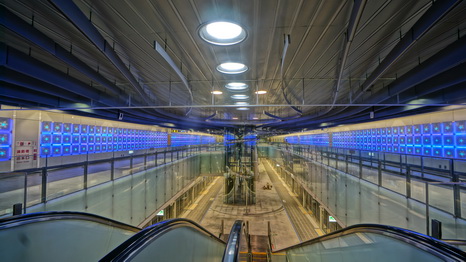
Circular Line Phase I
The Circular line Phase I is 15.4 km long (underground 1.2km, elevated 14.2km) and across four districts including Xindian, Zhonghe, Banqiao and Xinzhuang. There are 14 stations in total, and it is divided into three design contracts (DF111, DF112, DF113) which belong to three detailed design consulting companies. In order to unify the image of the whole line and create the characteristics of this line, DORTS has set the public art theme of the whole line as "Like the clouds' swift passage, the dragon travels thousands of miles," which refers to the design image of elevated beams and columns. The sub-theme of public art at each contract is based on each architectural theme, namely "Nature," "Photosynthesis," and "Heart LOHAS," with the respective design elements being "square," "triangle," and "circle.". Each work of architecture is mainly formed with steel structures and glass but suitably presents different design themes and theme colors on station finishing according to individual local contexts as follows:
- Contract DF111 (Y6 Dapinglin Station to Y7 Shisizhang Station) :
Because of the rich natural resources, such as Liugong Waterway, farm lands at Shisizhang, and Xindian River, the architectural design concept is "Nature". The design element is square and appears on elevation and seats. Furthermore, the line color of the Circular line is fully utilized on the interior finishing. - Contract DF112 (Y8 Xiulang Bridge Station to Y14 Banxin Station) :
The design theme is "Photosynthesis" and describes the communication of stations and local characteristics with seven natural reactions of photosynthesis. The design element is triangle and is displayed on elevations. A characteristic feature of this contract is the artistic finishing which is combined with public art themes and colors at sidewalls in vertical circulation space. Furthermore, the ceiling above the ticket gates also features artistic finishing, and the ceiling on the concourse level is specially designed with a linear lighting arrangement. - Contract DF113 (Y15 Banqiao Station to Y19 New Taipei Industrial Park Station):
Passing through areas such as New Banqiao Station Special Zone, Xinpu, Touqianzhuang, Xinchuang sub-downtown and New Taipei Industrial Park, this section is not only a transportation hub but also a booming new urban zone. Therefore "Heart LOHAS" is the architectural design theme and is expected to develop a new vision. The design element of the project is the circle, and it is applied at indoor columns, ceiling recesses and seats. The sidewalls at the vertical circulation spaces were designed by artist Emmanuelle Moureaux. She makes use of color collages according to the theme color of each station and makes each station look unique.
@ Introduction to Circular Line Phase I (Chinese/English)
@ Video of Circular Line Phase I (chinese)
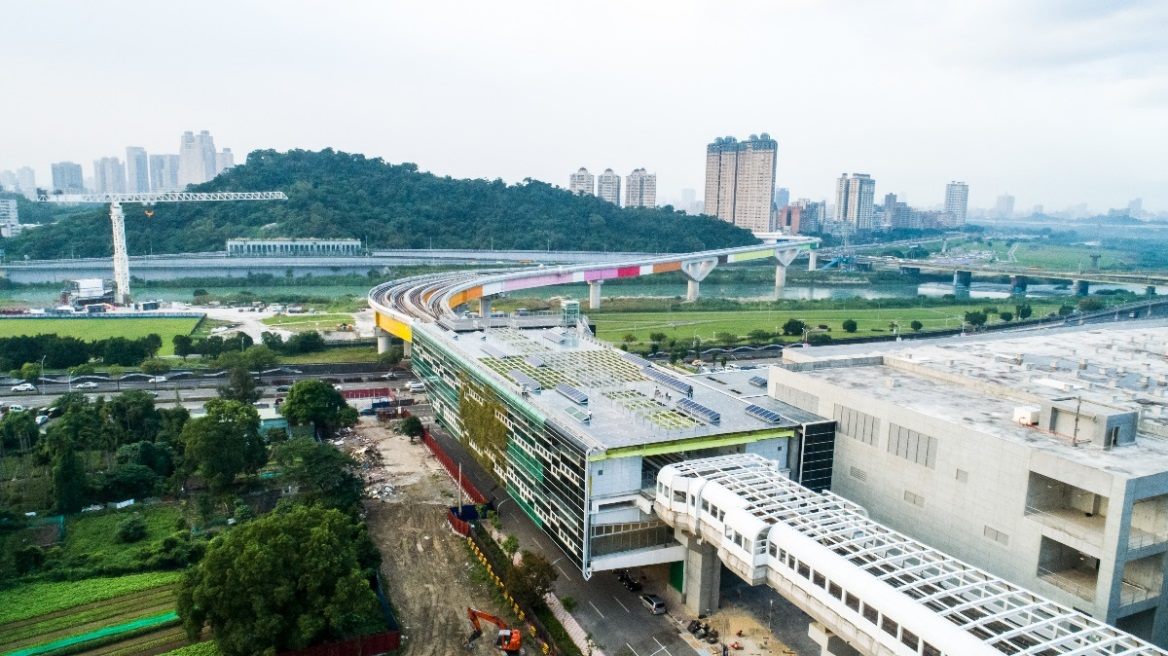
Shisizhang Station and Rainbow Bridge

![Taiwan.gov.tw [ open a new window]](/images/egov.png)
